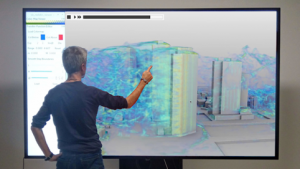After introducing in 2008 the first adaptive method capable of interactively visualizing static volumes of potentially unlimited size, CRS4 Visual Computing researchers made further progress by introducing various state-of-the-art compression methods (2012), in particular using sparse coding and tensor decomposition.
In 2019, a further evolution of these methods led to the conception and development of new models and techniques for supporting the interactive spatio-temporal exploration of very large dynamic data, achieving state-of-the-art performance.
The following articles, in particular, expand previous techniques working on static data to dynamic datasets:
- Fabio Marton, Marco Agus, and Enrico Gobbetti. A framework for GPU-accelerated exploration of massive time-varying rectilinear scalar volumes. Computer Graphics Forum, 38(3): 53-66, 2019.
- Jose Díaz, Fabio Marton, and Enrico Gobbetti. Interactive Spatio-Temporal Exploration of Massive Time-Varying Rectilinear Scalar Volumes based on a Variable Bit-Rate Sparse Representation over Learned Dictionaries. Computers & Graphics, 88: 45-56, 2020




